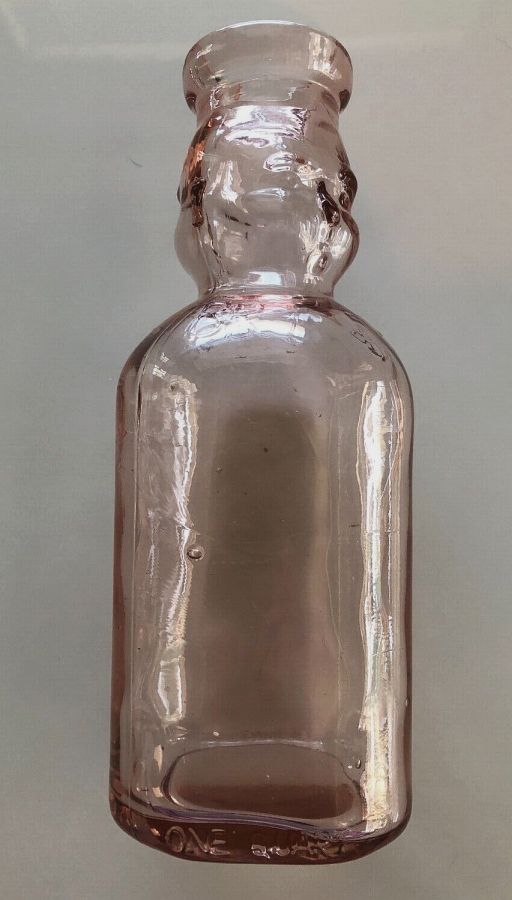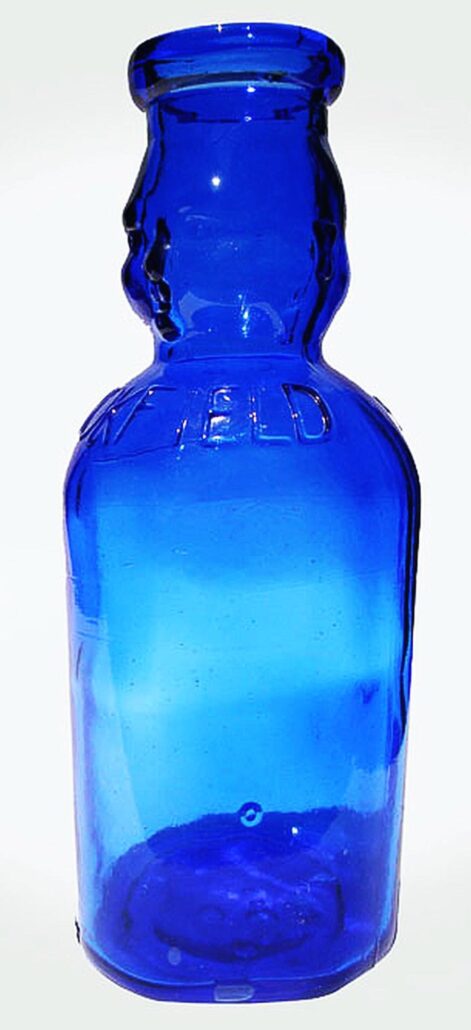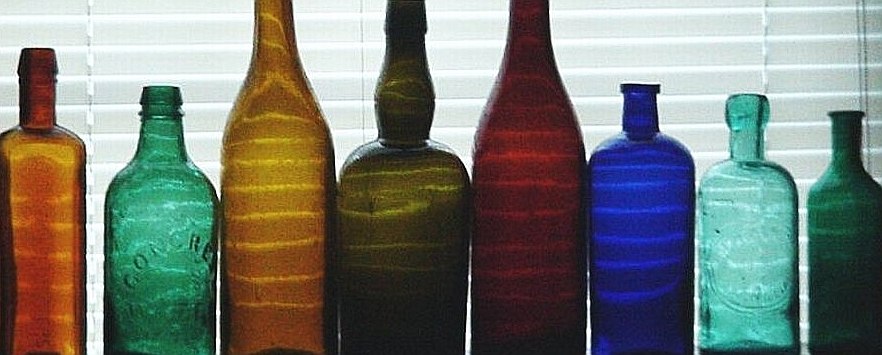BROOKFIELD BABY FACE MILK BOTTLES
Many collectors around the country see the “BROOKFIELD” brand name “BABY FACE” or “BABY TOP” milk bottles while browsing flea markets and antique malls, and confusion arises concerning how old these bottles are, and if they are authentic.
PLEASE NOTE: Milk bottles marked “BROOKFIELD” have nothing to do with the “BROOKFIELD GLASS COMPANY” that manufactured glass insulators. The Brookfield insulators date no later than 1921.
There ARE many authentic “Baby Face” or “Baby Top” style glass milk bottles that were made for a large number of U.S. dairies. Most of those date from the mid-20th century, primarily in the 1930s-1960s era. The bottles are most commonly of quart size, some of pint or half-pint size, and typically bear pyroglazed (ACL or “Applied Color Label”) labelling or embossed (raised) lettering, with the name of the dairy and city or town (where the operation was located) on the face of the bottle. Some of these kinds of bottles might be characterized as “generic” milk bottles, as there is no dairy or city name marked on them.
Many of the Baby Face bottles were manufactured by Lamb Glass Company of Mt. Vernon, Ohio. Lamb Glass Company bottles typically have an “LG 52” or “L 52” mark on them, usually on the lower heel area of the container. The 52 may be sitting “in the lap of the L”. Baby Top milk bottles were also made by Knox Glass Bottle Company, which used a “Keystone” emblem as their trademark.
(Note: I believe several other glass bottle makers also produced these types of bottles. If any readers have seen baby face style bottles with the mark of another glass company, please let me know about the mark and I can add that information to this article!).
BACKGROUND
Although the “Baby Face” bottle wasn’t invented until 1936, the basic idea of the “Cream separator top” bottle goes back at least to the 1920s. On March 3, 1925, patent #1,528,480 was issued to Norman A. Henderson for his new invention – a milk bottle with a “bulbous” or “head like” upper portion and a constriction between that and the lower (main) portion of the bottle. The bottle was designed so that the cream that rose to the top would be more or less contained within the “bulb” area, and a rubber disc attached to a handle could be inserted into the bottle, and then the cream poured off while the milk was retained in the bottom portion of the bottle. https://sha.org/bottle/pdffiles/creamseparatorbottle.pdf
On February 18, 1936, a refinement on that basic style of bottle was patented: the “Baby Top” bottle with the upper portion fashioned into the shape of a baby’s face. This patent (patent #98,609) was issued to Michael Pecora of West Hazleton, Pennsylvania and assigned to Pecora’s Farm Dairy. https://patents.google.com/patent/USD98609S/
Pecora’s Dairy at Hazleton, PA was the first dairy to use those bottles, but many other dairies (including BROOKFIELD DAIRY, HELLERTOWN, PA) eventually used the style but with their own name and city pyroglazed on them. Here is a link (courtesy of Worthopedia) to a typical pint size bottle from Pecora’s Dairy in Hazleton. The bottles were marked with the catchphrase “For Mothers Who Care”.
https://www.worthpoint.com/worthopedia/pint-baby-face-pecora-hazleton-pa-130805094
ADVERTISEMENT
Recent Reproduction Bottles
Virtually all of the older, original Baby Top milk bottles, no matter what dairy was represented, were manufactured in clear (or nearly colorless) glass. Some examples may have a very slight greenish tint, or a pale straw, pink or peach cast.

The majority of the reproduction bottles are found in cobalt blue or pink glass, but some repro Brookfield milk bottles were also made in clear (colorless) glass! A few have also been seen in emerald green (“Seven Up bottle” green), amber, or white milk glass. These colored bottles have been manufactured within the last several decades, most of them apparently dating the 1970s and 1980s, possibly into the 1990s. Some may date more recently than that. Large numbers of these bottles have been imported into the United States from Asia, principally China. (The glass company or companies that manufactured these bottles in China is not identified as far as I know). There are also smaller versions of some of the repro bottles, in pint and half-pint sizes.
NOTE: I don’t know of a 100% foolproof way to differentiate between the older CLEAR bottles and the clear repros, but in most cases, the older, authentic Brookfield bottles carry the name of the dairy along with the city name (Hellertown, PA), and are usually pyroglazed instead of being embossed. The bottles in clear glass that appear to be modern reproductions have no embossed markings on the base, which I think is also the case with virtually all of the repro bottles, no matter what color . The name “BROOKFIELD” is embossed in large block lettering on the shoulder. The repro bottles usually look shiny and brand new, with no damage or scratching at all. They show no base wear, and they have no glassmaker logo or mark to indicate who made them. From what I understand, they are also the type with a “double face” on the bottle.

The reproduction bottles are quite beautiful in their own right, and make great window displays, but it is important that collectors understand that they are not true, original milk bottles. Any seller that declares a cobalt blue, pink, amber or milk glass Brookfield milk bottle to be an old, authentic milk bottle is (either intentionally or accidentally) misrepresenting the piece.
Another type of repro/fake milk bottle which is seen fairly often is the “Thatcher” bottle with an embossed cow on the front. Those are also seen in unusual colors such as pink and yellow amber, and were made in Italy. None of them were intended to be actually used to deliver milk, but are decorator bottles sold through the China Crownford Company in the 1960s/1970s.
NOTE: Generally speaking, during the era of the heaviest use of milk bottles in the United States (typically circa 1910 to 1960) the great majority of milk bottles were made in clear glass to show off the white color of the milk. A few dairies used bottles that were made in amber or emerald green (but they are not baby-faced bottle types). Most of the colored authentic milk bottles probably date from the 1950s and ’60s.
In some other countries around the world, such as in the United Kingdom, milk bottles have seen common use much later than in the United States.
(Again, just a note that the Brookfield baby face milk bottles have NO connection whatsoever with the “BROOKFIELD” marked glass electrical insulators that were manufactured by the Brookfield Glass Company).
For an extensive alphabetical list of marks seen on bottles, fruit jars, electrical insulators and tableware, please click here to go to the Glass Bottle Marks pages (page one).
Click here to go to my Home Page.
ADVERTISEMENT


Hi I have a quart babytop from a Maine dairy (Saco) Maine 52 seal embossed. What makes the glass pink?
Hi Amy,
Many older clear glass milk bottles were made of glass that contained small quantities of manganese. Manganese is a decolorizer, and when added to the glass batch formula (“recipe”) it counteracts the effect of iron in the sand that was used to make the glass. Nearly all sand used for glassmaking has small quantities of iron in it. The presence of iron in the sand results in glass with a blue or green color, typically aquamarine or light green. So, the manganese “masks” the blue or green color and caused the resulting glass to appear clear or nearly colorless.
Manganese was used for many years in bottle making to produce clear glass, until the 1920s or 1930s when selenium became the preferred element for that purpose. When clear glass that contains manganese is exposed to sunlight over periods of time, the glass can turn shades of light to medium amethyst (purple) or lavender. Sometimes it may have a light pinkish lavender appearance.
Glass containing selenium as the decolorizer can turn shades of very light straw, yellowish, or pinkish-peach after long exposure to the ultraviolet rays in sunlight. Without seeing the exact shade of color of your bottle, I am not sure which element caused the color. It’s also possible small quantities of both elements were in the molten glass batch. Nearly all glass is made with some percentage of cullet (broken glass from older bottles) added to the sand and other ingredients.
I hope this will be of some help,
~David
I have a baby face milk bottle with Dressel Dairy/ Granite City, IL on it. It has the 52 in the lap of the L. On the bottom it has 2 capital D’s. You didn’t mention this marking in article.
Hi Jill,
There were many dairies around the country that used the “Baby Face” type milk bottles. I don’t list any of the dairy names specifically, other than one or two, mentioned in the text of my article. The L52 mark, as explained, shows the bottle was made by Lamb Glass Company. The “Two Ds” are the initials for Dressel Dairy, so since that isn’t a glassmaker mark I don’t have it listed in my list of marks. (Tens of thousands of different soda, mineral water, beer and milk bottles made over the years in the US have an initial or initials embossed on the base indicating the beverage company or dairy (the initials will match the company name), and, for the most part, in those cases, I haven’t attempted to list them, as it would be a monumental if not virtually impossible task). Thanks for your post!
David